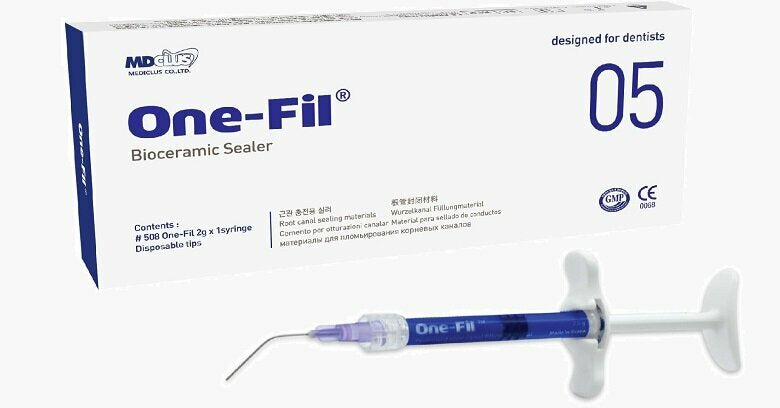Understanding the Evolution of bioceramic sealers
Before we delve into the differences between epoxy resin and bioceramic sealers, it's essential to understand the historical context of sealers in endodontics. The quest for an ideal sealer has been ongoing for decades, as practitioners have sought to address the shortcomings of traditional materials.
Zinc Oxide Eugenol-Based Sealers: In the earlier days of endodontics, zinc oxide eugenol-based sealers were commonly used. While they served the purpose of sealing the root canal, they had several drawbacks. These sealers lacked dimensional stability and exhibited poor material properties, necessitating the development of better alternatives.
Epoxy Resin Sealers: Epoxy resin sealers emerged as an improvement over zinc oxide eugenol-based sealers. They were developed to overcome some of the limitations associated with earlier materials. Epoxy resin sealers were characterised by improved material properties, increased dimensional stability, and reduced washout. However, they were not without their own set of challenges.
The Advantages of Epoxy Resin Sealers
Epoxy resin sealers represented a significant step forward in endodontic materials due to several notable advantages:
-
Improved Material Properties: Epoxy resin sealers demonstrated enhanced dimensional stability compared to their predecessors. This property made them less prone to shrinking or expanding over time, contributing to the overall stability of the root canal filling.
-
Dimensional Stability: The dimensional stability of epoxy resin sealers meant that they maintained their shape and size after setting, reducing the likelihood of gaps and leakage.
-
Reduced Washout: Epoxy resin sealers exhibited improved resistance to washout, ensuring that the sealer remained in place within the root canal.
However, despite these advantages, epoxy resin sealers had limitations including cytotoxicity and shrinkage that prompted further research and development in the field of endodontic materials.
The Dawn of Bioceramic Sealers
The transition from epoxy resin sealers to bioceramic sealers marked a significant turning point in endodontics. Bioceramic sealers, introduced in 2007, represented a new class of materials with unique properties that addressed many of the limitations associated with their predecessors.
Biocompatibility: Bioceramic sealers are highly biocompatible, making them ideal for use in endodontic procedures. They do not exhibit cytotoxicity, ensuring patient safety and minimising potential adverse reactions.
Chemical Bonding: Unlike epoxy resin sealers, which rely on physical adhesion, bioceramic sealers chemically bond to dentin. This chemical bonding creates a durable and stable seal that significantly reduces the risk of microleakage.
Antimicrobial Properties: Bioceramic sealers have a high pH, making them inherently antimicrobial. This property helps in disinfecting the root canal system, reducing the risk of reinfection.
Hydrophilic Nature: One of the standout features of bioceramic sealers is their hydrophilic nature. They readily interact with moisture, allowing for effective sealing even in the presence of residual moisture within the root canal.
Dimensional Stability: Bioceramic sealers do not undergo significant shrinkage upon setting, ensuring a stable and long-lasting seal. This property eliminates gaps and further reduces the risk of bacterial infiltration.
Minimal Technique Sensitivity: Bioceramic sealers have made it possible to adopt a passive or hydraulic condensation technique. Unlike traditional condensation methods that apply significant force to the root canal, this technique minimises stress on the tooth, reducing the risk of root fractures.
Reduced Root Fracture Risk: The hydroxyapatite-mediated bonding of bioceramic sealers inside the root canal minimizes condensation pressure on teeth, further reducing the risk of root fractures—a significant concern with traditional techniques.
The Impact of Bioceramic Sealers on Clinical Practice
The introduction and widespread adoption of bioceramic sealers have ushered in a new era of endodontic treatment. This revolutionary class of materials has brought several advantages to clinical practice:
-
Efficiency: Bioceramic sealers have streamlined the endodontic procedure. Their hydrophilic nature allows for effective sealing even in challenging clinical conditions, reducing the need for excessive drying and ensuring efficient treatment.
-
Effective Bonded Operation: Bioceramic sealers have paved the way for bonded or passive operation techniques. Unlike traditional condensation methods, which rely on physical force, bonded operation techniques maximize the sealing ability of the sealer itself. This results in a more stable and reliable root canal filling.
-
Less Technique Sensitivity: The adoption of bioceramic sealers has significantly reduced technique sensitivity. Practitioners no longer need to apply excessive force during condensation, minimizing the risk of iatrogenic damage to the tooth structure.
-
Improved Patient Outcomes: Bioceramic sealers contribute to better patient outcomes by reducing the risk of complications, such as root fractures and reinfections. Patients benefit from more efficient and comfortable endodontic procedures.
-
Long-Term Success: The superior properties of bioceramic sealers contribute to the long-term success of root canal treatments. With their antimicrobial nature, dimensional stability, and chemical bonding capabilities, bioceramic sealers offer a reliable solution for practitioners.
Future Directions in Endodontic Materials.
As research in endodontics continues to evolve, the role of bioceramic sealers is expected to expand further. Ongoing advancements in materials science and technology may lead to even more innovative endodontic materials that offer enhanced properties and further improve patient outcomes.
Conclusion.
In conclusion, the choice of sealer in endodontics plays a pivotal role in the success of root canal treatment. Their biocompatibility, chemical bonding, antimicrobial properties, hydrophilic nature, dimensional stability, and minimal technique sensitivity makes the bioceramic sealers the preferred choice for many practitioners.
Bioceramic sealers have not only enhanced the efficiency of endodontic procedures but may also contributed to improved patient outcomes. As research and development in endodontic materials continue to progress, bioceramic sealers are poised to become the future of endodontic cements, offering a promising path toward enhanced oral health and patient comfort.
The introduction of bioceramic sealers marks a significant milestone in the evolution of endodontics, and their ongoing development holds the potential to further advance the field, benefiting both practitioners and patients alike. With their remarkable properties and proven advantages, bioceramic sealers represent a promising future for the practice of endodontics.

